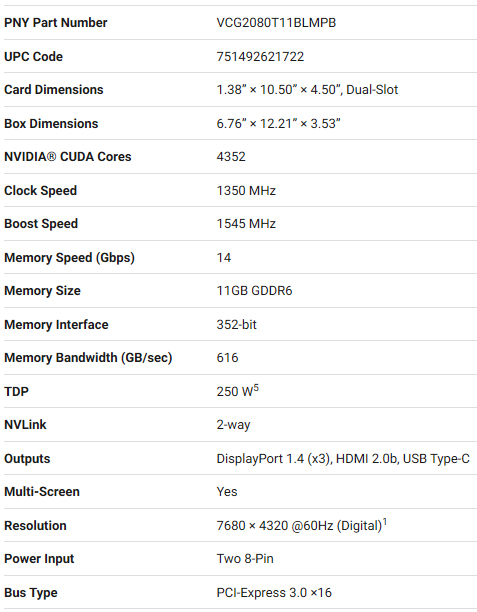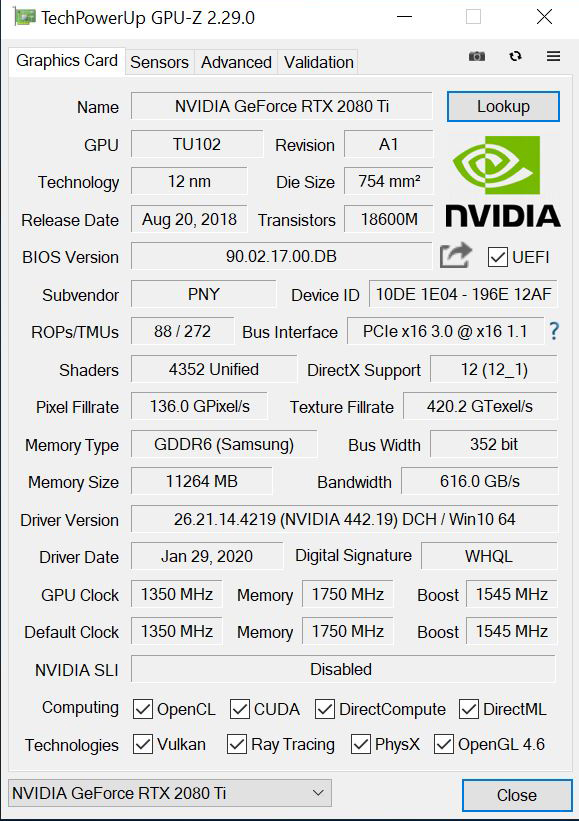PNY GeForce RTX 2080 Ti Blower Specifications
Here are the key specs from PNY:

The specifications for the PNY GeForce RTX 2080 Ti Blower match a normal RTX 2080 Ti, except for a lower Boost speed of 1545 MHz. The standard NVIDIA GeForce RTX 2080 Ti Boosts to 1635 MHz. A lower Boost speed helps to lower the heat output with heavy loads especially in dense configurations. If you are putting a single GPU in a workstation, this is not likely what you want. If you are putting eight or ten GPUs in a system, thermals become a constraint.
Testing the PNY RTX 2080 Ti Blower
Here is our test configuration:
- Motherboard: ASUS ROG Zenith II Extreme Motherboard
- CPU: AMD Threadripper 3960X (24 cores / 48 Threads)
- GPU: PNY RTX 2080 Ti Blower
- Cooling: NZXT Kraken X62
- RAM: 4x Corsair Dominator Platinum RGB 3600 MHz 16GB (64GB Total)
- SSD: Sabrent Rocket 4.0 NVMe PCIe Gen4 x4 M.2 SSD
- PSU: EVGA Supernova 1600 T2
- OS: Windows 10 Pro
Here is the obligatory GPU-Z shot of the PNY RTX 2080 Ti Blower:

GPU-Z shows the primary stats of our testing the PNY RTX 2080 Ti Blower. The GPU clocks in at 1,396MHz and can boost up to 1,545MHz as we saw from the spec sheet. Pixel Fillrates run at 136 GPixels/s, and Texture Fillrate comes in at 420.2 GTexel/s, while memory runs at 1,750MHz.
Let us move on and start our testing with computing-related benchmarks.




I wouldn’t touch anything from PNY with a 10 foot pole. Everything I’ve bought from them has died prematurely.
We rack 8 of the Supermicro 10 GPU servers adding about 3 racks a quarter. That isn’t much, but it’s 240 + 4 spare GPUs per quarter. We’ve been doing them since the 1080 Ti days. Our server reseller gets us good deals on other brands but says PNY doesn’t want the business as much so we get other brands.
I’m gonna be honest here. That cooler looks like they’re just using something cheap. I’d like to see PNY actually design a nice cooler like the old NVIDIA FE cards had with vapor chamber and a metal housing. Maybe if they’d do that they could keep clock speeds higher or even push them and have a better solution for dense compute like you’re saying.
If they’re not doing that, then its too easy to buy Zotac for GPU server and workstation
The octane benchmark is probably using a scene that doesn’t fit in 11GB of VRAM, hence the large difference between high VRAM cards. It doesn’t say much about the card’s actual performance since it is heavily bottlenecked by out-of-core memory accessing.
@IndustrialAIAdmin What brands and models do you run in such environment?